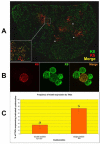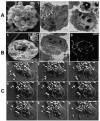Thymic nurse cells exhibit epithelial progenitor phenotype and create unique extra-cytoplasmic membrane space for thymocyte selection
- PMID: 20035931
- PMCID: PMC2830717
- DOI: 10.1016/j.cellimm.2009.11.004
Thymic nurse cells exhibit epithelial progenitor phenotype and create unique extra-cytoplasmic membrane space for thymocyte selection
Abstract
Thymic nurse cells (TNCs) are epithelial cells in the thymic cortex that contain as many as 50 thymocytes within specialized cytoplasmic vacuoles. The function of this cell-in-cell interaction has created controversy since their discovery in 1980. Further, some skepticism exists about the idea that apoptotic thymocytes within the TNC complex result from negative selection, a process believed to occur exclusively within the medulla. In this report, we have microscopic evidence that defines a unique membranous environment wherein lipid raft aggregates around the alphabetaTCR expressed on captured thymocytes and class II MHC molecules expressed on TNCs. Further, immunohistological examination of thymic sections show TNCs located within the cortico-medullary junction to express cytokeratins five and eight (K5 and K8), and the transcription factor Trp-63, the phenotype defined elsewhere as the thymic epithelial progenitor subset. Our results suggest that the microenvironment provided by TNCs plays an important role in thymocyte selection as well as the potential for TNCs to be involved in the maintenance of thymic epithelia.
2009 Elsevier Inc. All rights reserved.
Figures










Similar articles
-
The Antigenic Determinant That Defines Thymic Nurse Cells Is Expressed by Thymic Epithelial Progenitor Cells.Front Cell Dev Biol. 2014 Apr 28;2(13):13. doi: 10.3389/fcell.2014.00013. Front Cell Dev Biol. 2014. PMID: 25340052 Free PMC article.
-
Thymic Nurse Cells Participate in Heterotypic Internalization and Repertoire Selection of Immature Thymocytes; Their Removal from the Thymus of Autoimmune Animals May be Important to Disease Etiology.Curr Mol Med. 2015;15(9):828-35. doi: 10.2174/1566524015666151026102328. Curr Mol Med. 2015. PMID: 26511706 Free PMC article. Review.
-
Thymic nurse cell multicellular complexes in HY-TCR transgenic mice demonstrate their association with MHC restriction.Exp Biol Med (Maywood). 2007 Jun;232(6):780-8. Exp Biol Med (Maywood). 2007. PMID: 17526770
-
Lysosomal-mediated degradation of apoptotic thymocytes within thymic nurse cells.Cell Immunol. 1999 Nov 1;197(2):108-15. doi: 10.1006/cimm.1999.1559. Cell Immunol. 1999. PMID: 10607428
-
Molecular biological ontogenesis of the thymic reticulo-epithelial cell network during the organization of the cellular microenvironment.In Vivo. 1999 May-Jun;13(3):267-94. In Vivo. 1999. PMID: 10459506 Review.
Cited by
-
The Antigenic Determinant That Defines Thymic Nurse Cells Is Expressed by Thymic Epithelial Progenitor Cells.Front Cell Dev Biol. 2014 Apr 28;2(13):13. doi: 10.3389/fcell.2014.00013. Front Cell Dev Biol. 2014. PMID: 25340052 Free PMC article.
-
The thymus microenvironment in regulating thymocyte differentiation.Cell Adh Migr. 2010 Jul-Sep;4(3):382-90. doi: 10.4161/cam.4.3.11789. Epub 2010 Jul 15. Cell Adh Migr. 2010. PMID: 20418658 Free PMC article.
-
Children who develop type 1 diabetes early in life show low levels of carnitine and amino acids at birth: does this finding shed light on the etiopathogenesis of the disease?Nutr Diabetes. 2013 Oct 28;3(10):e94. doi: 10.1038/nutd.2013.33. Nutr Diabetes. 2013. PMID: 24166423 Free PMC article.
-
The importance of the nurse cells and regulatory cells in the control of T lymphocyte responses.Biomed Res Int. 2013;2013:352414. doi: 10.1155/2013/352414. Epub 2012 Dec 26. Biomed Res Int. 2013. PMID: 23509712 Free PMC article. Review.
-
Guilty bystanders: nurse-like cells as a model of microenvironmental support for leukemic lymphocytes.Clin Exp Med. 2015 Feb;15(1):73-83. doi: 10.1007/s10238-013-0268-z. Epub 2013 Dec 12. Clin Exp Med. 2015. PMID: 24337970 Free PMC article.
References
-
- Overholtzer M, Brugge JS. The cell biology of cell-in-cell structures. Nat Rev Mol Cell Biol. 2008;9:796–809. - PubMed
-
- Wekerle H, Ketelsen UP. Thymic nurse cells--Ia-bearing epithelium involved in T-lymphocyte differentiation? Nature. 1980;283:402–4. - PubMed
-
- Boyd RL, Oberhuber G, Hala K, Wick G. Obese strain (OS) chickens with spontaneous autoimmune thyroiditis have a deficiency in thymic nurse cells. J Immunol. 1984;132:718–24. - PubMed
Publication types
MeSH terms
Substances
Grants and funding
LinkOut - more resources
Full Text Sources
Medical
Research Materials
Miscellaneous

